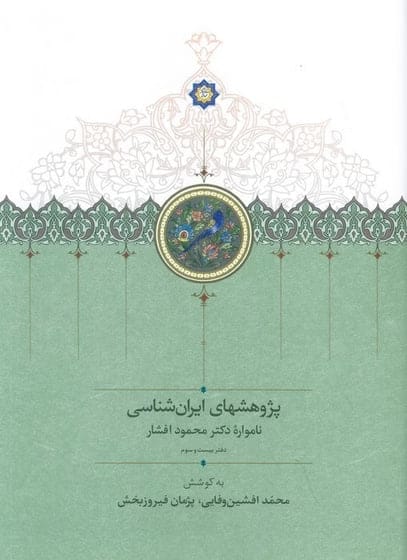Afshin-Vafaie, Mohammad & Pejman Firoozbakhsh (eds.). 2024. Studia Persica in memory of Dr. Mahmoud Afshar Yazdi, volume 23. Tehran: Dr. Mahmoud Afshar Endowment Foundation.
The volume contains several interesting papers on different aspects of Iranian Studies. Here is the table of contents:
- S. ALIYARI BABOLGHANI: Old Persian <θ> /θ₁, θ₂/: Phonetic Value(s) and Phonological Development(s) into Middle Persian
- D. DURAND-GUÉDY: The State of the Rum Saljuqs as Reflected in the Honorific Titles (alqāb) of its Servants: Edition and Commentary of the khiṭāb Section of Ms. Marʿashī 11136 (Qiṣṣa-yi salāṭīn)
- A. A. KHOSRAVI: Pahlavi Inscriptions in the Name of Yazdgird III on Silk Textiles Found in China
- D. STILO: The Category of Stative in Three Iranian Languages
- A. A. TONOYAN & V. S. VOSKANIAN: Caucasian Persian (Tati): History of Study, Current State and Perspectives
- S. AYDENLOO: A Reconsideration of the Infinitive čaftan and its Use in the Shahnameh
- A. ARGHAVAN: Saʿdī’s Tomb and the Oldest Representations of the Čahāršanba-sūrī Festival in Shahnameh Manuscripts
- I. AFSHAR: Bookbinding
- M. AFSHIN-VAFAIE: Dodarz madōz: Concerning One of Ḫusraw Anōširwān’s Dicta
- M. OMIDSALAR: Nibelungenlied as a Folk Epic and the Shahnameh as a Literary Epic
- B. IMANI: Anwār al-Rawḍat wa Asrār al-Bayḍat: Similes of Sayf al-Dīn Isparanganī’s Lost Work, Rawḍat al-Quds wa Bayḍat al-Uns
- H. BORJIAN: Persian Lexemes in the 14th-Century Rasulid Hexoglot
- J. BASHARI: The Compendia of Asʿad b. Aḥmad Kātib, a Shirazi Sufi from the 15th Century CE
- A. R. BAHARLOO & K. MOTAGHEDI: The Šikl-i Šāh Relief at Tanga-yi Band-i Burīda: The Last Qajar Rock-carving from the Time of Naser-al-Din Shah
- S. SAJJADI: Zaryāb, the Creative Cultural Architect
- Y. SAADAT: The Origin of the Philosophical Senses of Middle Persian Words ǰahišn and ǰadag and the Arabic Word ʿaraḍ
- M. R. SHAFI’I KADKANI: Qazvin’s Public and Private Libraries from the beginning to the 13th Century CE
- E. SHEYKH-OL-HOKAMAEE & P. AKBARI: The Mosque of the Šayḫ al-Islām Madrasa in Qazvin and its Endowment Document, dated 1903
- A. A. SADEGHI: On Muṣāḥib’s Persian Encyclopedia
- A. SAFARI AGH-GHALEH: The Background of the Wāq Figure in Iranian Art and its Relationship to the Wāq-Wāq and Zaqqūm Trees
- A. TABIBZADEH: Šammarān or Hāmāwarān? A Toponym in Iranian Mythical and Historical Sources
- M. ABDEAMIN & B. ABOUTORABIAN: Tehran Arg Mosque, Also Known as Masǧid-i Mādar-i Fatḥʿalī-Šāh
- M. EMADI HAERI: Three Ascetic Verses from the 11th Century CE: Newly-found Verses by Abū al-Muẓaffar Tirmadī and Ḫwāǧa Imām-i Zāhid
- P. FIROOZBAKHSH: The Persian Translation of al-Fātiḥa Attributed to Salmān-i Fārsī
- A. R. QAEMMAQAMI & V. IDGAH TORGHABEHI: The Word, bīmār: A Study of its Etymology and Pronunciation
- M. MOHAMMADI: On the Fahlavi Origin of the Wīs u Rāmīn
- D. MONCHI-ZADEH: Die Fabelwesen (Persian translation by A. R. QAEMMAQAMI)
- R. MOUSAVI TABARI: An Investigation of Two Persian Words: low and lāw








